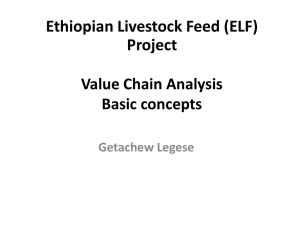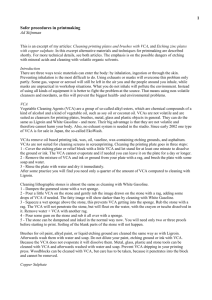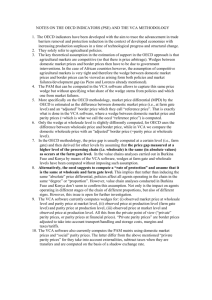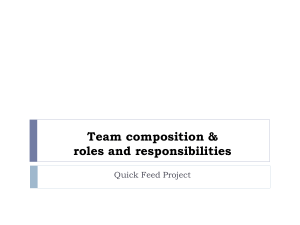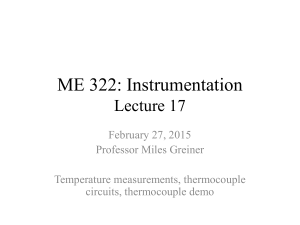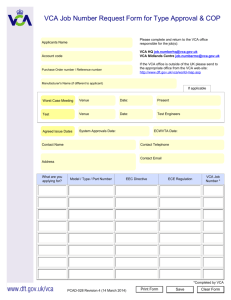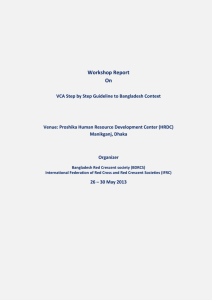Gaza Risk Reduction and Mitigation (GRRAM)
advertisement
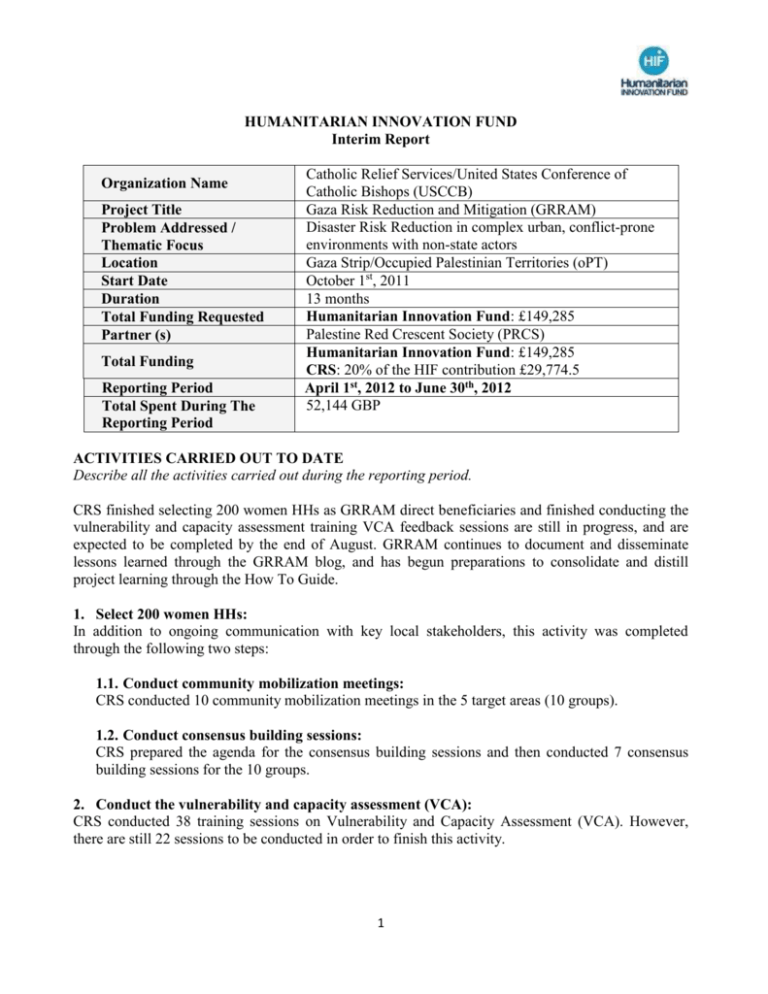
HUMANITARIAN INNOVATION FUND Interim Report Organization Name Project Title Problem Addressed / Thematic Focus Location Start Date Duration Total Funding Requested Partner (s) Total Funding Reporting Period Total Spent During The Reporting Period Catholic Relief Services/United States Conference of Catholic Bishops (USCCB) Gaza Risk Reduction and Mitigation (GRRAM) Disaster Risk Reduction in complex urban, conflict-prone environments with non-state actors Gaza Strip/Occupied Palestinian Territories (oPT) October 1st, 2011 13 months Humanitarian Innovation Fund: £149,285 Palestine Red Crescent Society (PRCS) Humanitarian Innovation Fund: £149,285 CRS: 20% of the HIF contribution £29,774.5 April 1st, 2012 to June 30th, 2012 52,144 GBP ACTIVITIES CARRIED OUT TO DATE Describe all the activities carried out during the reporting period. CRS finished selecting 200 women HHs as GRRAM direct beneficiaries and finished conducting the vulnerability and capacity assessment training VCA feedback sessions are still in progress, and are expected to be completed by the end of August. GRRAM continues to document and disseminate lessons learned through the GRRAM blog, and has begun preparations to consolidate and distill project learning through the How To Guide. 1. Select 200 women HHs: In addition to ongoing communication with key local stakeholders, this activity was completed through the following two steps: 1.1. Conduct community mobilization meetings: CRS conducted 10 community mobilization meetings in the 5 target areas (10 groups). 1.2. Conduct consensus building sessions: CRS prepared the agenda for the consensus building sessions and then conducted 7 consensus building sessions for the 10 groups. 2. Conduct the vulnerability and capacity assessment (VCA): CRS conducted 38 training sessions on Vulnerability and Capacity Assessment (VCA). However, there are still 22 sessions to be conducted in order to finish this activity. 1 ACHIEVEMENTS TO DATE Describe all the results achieved through the activities indicated above. 1. Select 200 women HHs: 1.1. Conduct community mobilization meetings: Three-hundred and thirty-one participants from the five target areas were oriented about GRRAM and completed GRRAM applications. All data was entered into an Excel sheet. Two-hundred (20 people for each of the 10 groups) households’ applications were selected according to applying the following selection criteria. 1. Age: above 18 years old. 2. Have vulnerable members (i.e. children under CRS staff member helps a participant in filling the age of 10, disabled, elderly, etc). GRRAM application. Date: May 2012. Place: Middle 3. A high dependency ratio (# of income area of Gaza Strip. Photo taken by Heba Abukmail earners, # of family members). (GRRAM Project Officer). 4. A DRR group should be 20 HHs families. 5. DRR group members should be from the same geographical area. In high-density areas, for example an apartment complex or a city block. 6. A DRR group should be willing, interested and have a high-level of social cohesion and leadership. 7. In some cases, DRR groups may select households to participate who do not meet the vulnerability criteria but who would be valued as trusted members. This is permissible as long as the majority of the other HHs in the group meet the criteria. Lessons learned are: Local stakeholder input into mobilization activities is essential for full participation: The team asked key local stakeholders and local CBOs to invite local households to the community in order to account for significant variations in potential participant mobility, availability, and interest across seemingly homogenous target areas. For instance, in one of the areas, women could not leave their houses to attend trainings or meetings unless their husbands permitted them to do so. So, only women who were able to get the permission on their own participated in the project. Hold community mobilization meetings prior to project launch: Community-led DRR is still an unfamiliar concept in Gaza, and 2 Local women HHs attend a community mobilization meetings. Date: May 2012. Place: Northern area of Gaza Strip. Photo taken by Ola Hajjaj (GRRAM Project Coordinator) participatory development in general is much less common than in the rural communities where CRS has traditionally undertaken DRR activities. Consequently, before launching beneficiary selection and VCA activities, it was necessary for the GRAAM team to undertake extensive community mobilization meetings in order to introduce the basic concepts of DRR, help participants determine if they wish to participate, and assist participants in completing applications. While these pre-mobilization meetings were vital for community acceptance, participation, and understanding, they added a layer of preparation and coordination beyond what might have been undertaken in a rural community more accustomed to participatory development. 1.2. Conduct consensus building sessions: CRS/PRCS conducted consensus building sessions with the 200 selected participants for the purpose of strengthening intra-group dynamics and to ensure that the groups function for the project’s duration and beyond. During these meetings, different principles were agreed on with the participants including flexibility, commitment, responsibility, dialogue, and relationship. Also, CRS ensured that households understand the project’s purpose, objectives, and key activities. PRCS Field Coordinator ensures that group members understand the project’s purpose, objectives, and key activities. Date: May 2012. Place: Gaza City. Photo taken by Ola Hajjaj (GRRAM Project Coordinator) 2. Conduct the Vulnerability and Capacity Assessment (VCA): The main aim of this activity is to acquire data for the VCA baseline, including the hazards, vulnerabilities, capacities, risks, needs, strategies, and action plans. The VCA training consisted of 6 days - 4 training days and two workshop days. Each group is comprised of 20 women who live in the neighborhood, are self-selecting and are vulnerable. The steps of the VCA are as follows: 1) use the PRCS/ICRC manual VCA tools in the training, 2) conduct the VCA training, and 3) assess the data with the community. So far, the project is still on the second step. The analysis of the data A group of participants brainstorm will be used for the purpose of planning projects designed to about their hazards of their area to reduce risk and vulnerability. A complete VCA report of all be presented to the group. A photo areas will be finalized at the end of the training, examining taken by Ola Hajjaj (GRRAM Project common trends in hazards, vulnerabilities, capacities, risks, Coordinator) needs, strategies, and actions to mitigate the hazards. Also, an evaluation of the training will be done at the end of the training. The VCA tools used for the 38 workshops include semi-structured interviews, focus group discussions, direct observation, and mapping. In addition, the women used the analysis methods of ranking and problem tree. 3 The main lessons learned from this activity are: Education and literacy levels in vulnerable urban settings vary widely, and mobilization materials must account for these variations: VCA trainers simplified the training material to suit the diverse education levels and ages of participating women, many of whom had little or no education. Trainers noticed during sessions that by forming groups of women with mixed levels of education, it helped the women to identify hazards, vulnerabilities, needs, and capacities- as women with more education could assist others to better express themselves and document the process. In addition, trainers used a wide range of training tools, such as video clips, photos and presentations about other DRR experiences from around the world, so that the women could better understand how VCAs assist families and communities. Despite attending 4-day VCA training sessions, some women were confused in differentiating hazards, needs, and vulnerabilities. To mitigate this obstacle, GRRAM trainers provided more facilitation while being careful to not influence the outcomes. Encouraging participants to select their own VCA tools helps to accommodate for the significant variations that can occur between geographically proximate communities in urban settings: When conducting any project that requires VCA training, PRCS adopts the methodology to engage the trainees extensively in selecting the right VCA tools for their communities in order to identify their hazards, potential risks, capabilities, and vulnerabilities. The selected VCA tool/s is one of the 14 VCA tools mentioned in ICRC/PRCS manuals on VCA. A participant explains a group work of the hazard mapping in her area. Date: May 2012. Place: South of Gaza Strip. Photo taken by Zain AbuQasim (GRRAM Project Coordinator) This inclusive process empowers participants to choose the correct tools for their communities depending on their specific context. For example, one of the group’s members preferred to use the semi-structured interview tool for collecting information. The strong social relations between these groups’ members and their neighbors, as they are living close to each other in the same geographical area and most of them are from extended families, is the reason for the selection of this tool which is more convenient to conduct with people that the group’s members know. However, a second group preferred to use the mapping tool for collecting the information. This could be explained by the fact that these group’s members are living in a wider geographical area and the social relations are weaker than the first group. However, in some cases GRRAM trainers had to modify the way women used the VCA tools in order to collect the accurate information from the field. This was done because some of the groups’ members were not conducting the selected VCA tools properly according to the manuals of the ICRC/PRCS. So, the trainers held follow-up meetings with the women during the information collection phase to ensure proper usage of the VCA tools. 4 Follow up during the information gathering: The low educational level of the participants compelled the field team to follow up with the women during the process of information collection about their families and neighbors’ hazards, risks, capabilities, and vulnerabilities, in order to verify that the VCA messages had actually been understood. For this purpose, different informal meetings were conducted with the groups to review and discuss the process of information gathering before presenting formally in workshops. These informal meetings required both trainers and project team to understand the cultures of the participants. During the follow-up process, many of the participating women showed their appreciation for the team members, especially for the female ones who were open to hearing women’s personal stories. This further emphasized that gender needs to be considered while constituting the field teams. Urban participants in the Gaza Strip have differences related to their unique situation of living in urban conflict prone areas; difference in the interests of the hazards priorities, educational level, and in the communities cultures. Different target areas’ participants showed different priority of hazards although all of them live in conflict-prone areas. For example, in some areas the first priority for the participants is the military incursions and the need to properly respond in times of such situations. However, for some other areas, the priority was different; day to day hazards, such as car accidents, electric generators, weak infrastructure, poverty, and unemployment. Differences in educational levels also affected the mitigation strategies of the participants to the hazards they face and the selection of the groups’ VCA tools. The focus on the day-to-day hazards was noticed in the priorities of the urban participants despite having a training of the different types of disasters, including natural disasters. None of the participants identified natural disasters in their priorities during conducting the VCA training. It is obvious that the Gaza urban participants are not prepared for natural disasters. So awareness for people of urban conflict areas of Gaza Strip should be raised in terms of the natural disasters, especially since the area is susceptible to natural hazards such as earthquakes. Urban participants of the target areas have different cultures that dominate the social relations between the families and neighbors of these areas. There are urban areas of some participating groups where social relations are strong and for other it is not. Strong relations are explained by having extended families in these areas. These families can help and support each other during times of crisis. However, looking at the wider perspective of those areas, it is found that many of those participants have poor connections and influence with the players either in their close areas or the surrounding ones. Urban participants of GRRAM groups are hard to manage, because of the many commitments of the urban life styles, such as families, educational system, health system, social relations, and others besides of the level of social status of being vulnerable households. One example that the team had to stop the project activities for two weeks in order for the families to finish the exams of their kids. Another example, some meetings had to be delayed because of social events that the participants had to attend during conducting the training. 5 Conflict-affected urban vulnerable participants of GRRAM are facing problems with the absence of the many municipal services which makes their life hard and increase the level of different risks that they face. Despite the fact that the government is functioning in some other urban areas; the municipal services tend to be less in the more conflict prone areas and the governments tend to be less caring about such areas because of their sensitive political situations, which makes the people living in these areas more vulnerable and the most affected by any potential disasters. For example, the poor participants had to move longer distanced in order to reach the nearest governmental services areas. Poor participants of the urban conflict areas are having less interest in mobility outside of their community for participating in social events or trainings, this is for two main reasons, their high commitment to their families, the other reason, and they do not bear finically the cost of the mobility from one area to another. METHODOLOGY Describe how the methodology used is or isn’t appropriate to carry out the activities or achieve the objectives set out. The methodology used is appropriate for the following reasons: 1. Selecting 200 women via a transparent and systematic process is appropriate, as it ensured the women meet the criteria of self-selection and vulnerability. 2. The VCA training methodology was appropriate as it built on the best practices stated in the ICRC/PRCS VCA manuals and therefore ensured thorough implementation of the VCA activities. Indicate whether amendments to the planned activities need to be made in order to achieve the results–justify thoroughly and provide a detailed work plan below setting out the new milestones and objectives where applicable. CRS will shortly send a request for a two-month no-cost extension along with an updated work plan. Indicate if there is a need to revise the methodology used to date – justify thoroughly and provide details of the revised approach. At this time, there is no need for revising the methodology used to date. OBSTACLES AND STEPS TAKEN TO ADDRESS THEM Describe all the obstacles faced during the implementation period and how they affected the planned activities and results. 1. Ensuring attendance of the different meetings as the participants are grassroots women who have many family commitments. 2. Explaining the training material of PRCS/ICRC VCA manuals was difficult as the material was intended for participants with a higher level of literacy and formal education. 6 Indicate what steps have been taken to address these obstacles in the upcoming period. 1. Be flexible in time and place of the meetings. Also, continuous informal follow-up from the field team with the participants to address their concerns before conducting the formal workshop and to confirm their commitment to the training. 2. Simplify the presentation of training material through shortened PowerPoint presentations, group discussions and other learner-focused training methods. UPDATED WORK PLAN / OBJECTIVES / MILESTONES Submitted as part of no-cost extension request DISSEMINATION Indicate the steps taken to disseminate project findings/outputs to outside stakeholders. Describe any plans for further dissemination 1. GRRAM Blog with regular updates including lessons learned and flip videos. 2. Final findings of the project will be developed in the How-To-Guide at the end of the project period. 7
